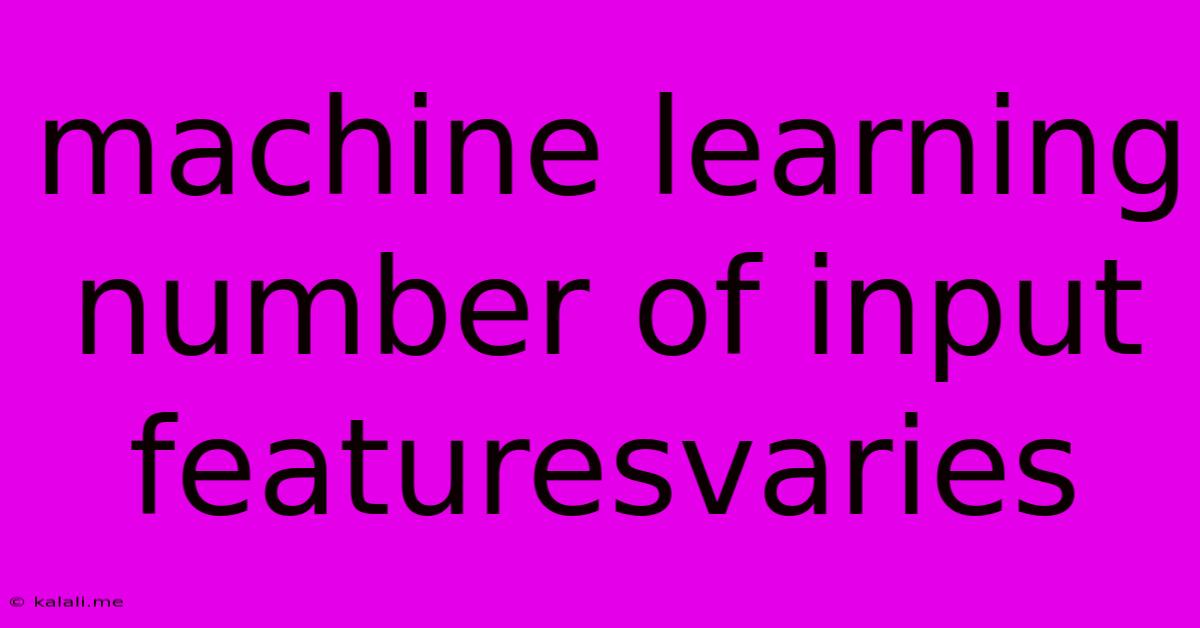Machine Learning Number Of Input Featuresvaries
Kalali
May 23, 2025 · 3 min read

Table of Contents
Dealing with Variable Numbers of Input Features in Machine Learning
Machine learning models thrive on data, but the nature of that data can be surprisingly diverse. One common challenge is dealing with a variable number of input features. This means that each data point might not have the same number of attributes or characteristics. This article will explore various strategies for handling this issue, ensuring your machine learning models can effectively process and learn from such datasets. Understanding how to address this problem is crucial for building robust and accurate predictive models.
Understanding the Problem: Why Variable Input Features Matter
Traditional machine learning algorithms often assume a fixed number of input features. They expect each data point to have a predefined set of attributes. When dealing with variable-length data, such as text documents (varying sentence lengths), time series with missing values, or customer transaction records with differing numbers of items purchased, this assumption breaks down. Simply padding or truncating data can lead to information loss or introduce bias, negatively impacting model performance.
Strategies for Handling Variable Input Features
Several techniques can effectively manage datasets with varying numbers of input features. The best choice depends on the specific characteristics of your data and the chosen machine learning model.
1. Data Transformation Techniques:
-
Padding and Truncation: This is the simplest approach but can be problematic. Padding involves adding placeholder values (e.g., zeros) to shorter sequences to match the length of the longest sequence. Truncation, conversely, shortens longer sequences to match the shortest. While straightforward, this method can introduce bias if not carefully considered.
-
Feature Extraction: This involves creating new features that capture the essence of the variable-length input. For example, with text data, techniques like TF-IDF (Term Frequency-Inverse Document Frequency) or word embeddings (Word2Vec, GloVe) can transform variable-length text into fixed-length vector representations. Similar approaches can be used for time series data or other types of variable-length sequences. This method often leads to better performance than simple padding or truncation.
2. Model Selection:
Certain machine learning models are naturally better suited to handle variable-length inputs.
-
Recurrent Neural Networks (RNNs): RNNs, particularly Long Short-Term Memory (LSTM) networks and Gated Recurrent Units (GRUs), are specifically designed for sequential data and can effectively process sequences of varying lengths. They maintain a hidden state that captures information from previous time steps, allowing them to handle variable-length inputs without requiring padding or truncation.
-
Tree-based models: Decision trees and random forests can naturally handle missing values and varying numbers of features. They don't rely on fixed-length inputs.
-
Sequence-to-Sequence Models: These models are particularly useful when dealing with translation tasks or other situations where the input and output sequences have variable lengths.
3. Data Augmentation:
In some cases, data augmentation can help mitigate the impact of variable input features. For instance, you might artificially generate new data points by randomly sampling or combining existing ones. This approach, however, should be used cautiously to avoid introducing unwanted biases.
4. Missing Value Imputation:
If missing values contribute to the variability of input features, employ appropriate imputation techniques. Methods such as mean imputation, median imputation, or more sophisticated techniques like k-Nearest Neighbors imputation can fill in missing values and help create a more uniform dataset.
Choosing the Right Approach
The optimal approach depends on several factors:
- The type of data: Text, images, time series, or other types of data require different strategies.
- The size of the dataset: Larger datasets might tolerate simpler approaches, while smaller datasets may benefit from more sophisticated methods.
- The computational resources: Some techniques, like RNNs, are computationally expensive and may not be feasible for all situations.
- The desired level of accuracy: More complex methods often lead to higher accuracy but require more effort.
Addressing variable numbers of input features requires careful consideration of your data and the chosen machine learning model. By understanding the available techniques and choosing the appropriate strategy, you can build robust and effective machine learning models that deliver accurate predictions even with complex, variable-length datasets. Remember to experiment and compare different approaches to find the best solution for your specific problem.
Latest Posts
Latest Posts
-
What Is 1 5 Of A Tablespoon
Jun 30, 2025
-
How Long Does It Take To Drive Through Illinois
Jun 30, 2025
-
If I Was Born In 1988 How Old Am I
Jun 30, 2025
-
How Much Is 800 Grams Of Chicken
Jun 30, 2025
-
How Long Will It Take To Walk 20 Miles
Jun 30, 2025
Related Post
Thank you for visiting our website which covers about Machine Learning Number Of Input Featuresvaries . We hope the information provided has been useful to you. Feel free to contact us if you have any questions or need further assistance. See you next time and don't miss to bookmark.